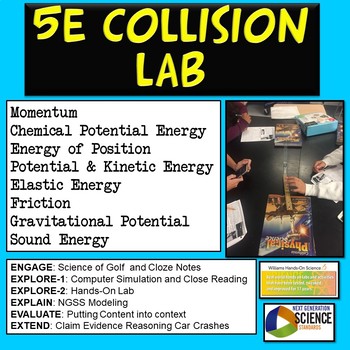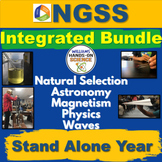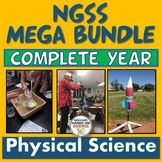Forces Motion & Energy MS-PS2-2: 5E NGSS Activity Close Reading & Notes CER
- Zip
Also included in
- Your students will remember these activities forever! These are student centered, challenging, hands-on, engaging activities that will wow and motivate even some of the most reluctant learners. I also include an editable unit test and a modified Special Education/English Language Learner test. I’vePrice $59.97Original Price $88.75Save $28.78
- Looking for a complete, standalone year-long curriculum for integrated NGSS Physics, Energy, Waves, Astronomy, Earth’s History, Science and Engineering Practices, Crosscutting Concepts, and Evolution? Look no further than this student-centered, inquiry-based, hands-on bundle! Designed to align withPrice $205.00Original Price $366.00Save $161.00
- This bundle is a time-saving, comprehensive and user-friendly complete year bundle for physical science Teachers that will streamline your teaching experience effortlessly! Every lesson is meticulously planned and just a click away. This extraordinary bundle is a treasure trove of engaging resourcesPrice $176.00Original Price $311.50Save $135.50
Description
This product will WOW your students and challenge them! It’s NGSS aligned, it’s a rigorous 2 day block period 5E and relatively easy prep! I also include 8 pages of very detailed notes, a key and my email if you have any questions. Read below for the details.
The following concepts are included:
-Energy
-Kinetic Energy
-Potential Energy
-Energy Transfer
-Momentum
-Friction
-Heat
-Sound
- Gravitational Potential Energy
- Energy of Position and Motion
-Chemical Potential Energy
-Elastic Energy
NGSS Standards:
Science and Engineering Practices
Developing and Using Models
Modeling in 6–8 builds on K–5 experiences and progresses to developing, using, and revising models to describe, test, and predict more abstract phenomena and design systems. Develop a model to describe unobservable mechanisms. (MS-PS3-2)
Analyzing and Interpreting Data
Engaging in Argument from Evidence
DCI'S
PS3.A: Definitions of Energy
Motion energy is properly called kinetic energy; it is proportional to the mass of the moving object and grows with the square of its speed. (MS-PS3-1)
A system of objects may also contain stored (potential) energy, depending on their relative positions. (MS-PS3-2), When the motion energy of an object changes, there is inevitably some other change in energy at the same time. (MS-PS3-5)
PS3.C: Relationship Between Energy and Forces
When two objects interact, each one exerts a force on the other that can cause energy to be transferred to or from the object. (MS-PS3-2)
Cross Cutting Concepts
Scale, Proportion, and Quantity
Proportional relationships (e.g. speed as the ratio of distance traveled to time taken) among different types of quantities provide information about the magnitude of properties and processes.(MS-PS3-1), (MS-PS3-4)
Systems and System Models
Models can be used to represent systems and their interactions—such as inputs, processes and outputs—and energy and matter flows within systems. (MS-PS3-2)
Energy and Matter
The transfer of energy can be tracked as energy flows through a designed or natural system. (MS-PS3-3)
Energy may take different forms (e.g. energy in fields, thermal energy, energy of motion). (MS-PS3)
5E:
Engage: (5 mins) I have the students individually watch the YouTube clip “Science of Golf: Potential and Kinetic Energy” on either my computer or their own devices. They fill in the cloze notes using a word bank.
Explore-1: (20mins) After they finish the cloze notes, we move on to the close reading and then thephysicsclassroom.com. The students individually experiment with the simulation and eventually calculate Momentum. We then discuss the calculations and go over those answers. This will then segue into the Collision Lab in
Explore-2: (10mins modeling lab, 5 mins discussing student's hypothesis and 20 mins doing lab)
Explain: (15 minutes) Students revise their NGSS models of the hands-on lab
Evaluate: (20 minutes) Students answer challenging and rigorous questions.
Extend: (20 minutes) Students do a Claim Evidence Reasoning graphic organizer for the physics of car crashes.
Extra Credit Challenge Option: Students calculate Kinetic Energy.
TERMS OF USE
• All rights reserved by Williams Hands On Science, Inc.
• This product is to be used by the original purchaser only.
• Intended for classroom and personal use only.
• Copying for more than one teacher, classroom, department, school, or school system is prohibited.
• This product may not be distributed or displayed digitally for public view.
• Failure to comply is a copyright infringement and a violation of the Digital Millennium Copyright Act (DMCA).
If there are any errors or questions, please contact me through TpT or email me at:
williamshandsonscience@gmail.com
Thank you for taking a look!
Please follow me on TpT for new products and check me out on Instagram for my products in action!
https://www.instagram.com/williams_hands_on_science/
Take a look at my bundles
Physical Science Growing Bundle
Take a look at some other products in my store:
Elements, Atoms, Compounds and Molecules Card Sort
Flipping the Classroom Periodic Table Frayer Models
Physical Science Scaffolded Notes
NGSS Speed, Time, Distance, Acceleration and Graphing Worksheets
Physics Speed, Time and Distance Problems
STEM Paper Airplane Competition
Physical Science Scaffolded/Guided Notes for a Year + 8 PREZIS
NGSS Kinetic and Potential Energy Card sort








